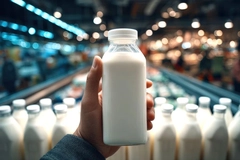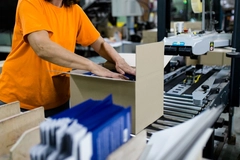EU finalizes adoption of single-use plastic ban, fans the circular economy flames
Member states have two years to transpose the legislation, while optimists point to budding market opportunities

22 May 2019 --- The Council of the EU has officially adopted measures proposed by the European Commission to tackle marine litter by banning the 10 single-use products most commonly found on European beaches. This includes cotton bud sticks, cutlery, plates, straws and stirrers and also incorporates abandoned fishing gear and oxo-degradable plastics. The Member States will now have two years to transpose the legislation into their national law.
Where alternatives are easily available and affordable, single-use plastic products will be banned from the market. For other products, the focus is on limiting their use through a national reduction in consumption; on design and labeling requirements; and waste management/clean-up obligations for producers.
The new rules will introduce:
- A ban on selected single-use products made of plastic for which alternatives exist on the market: cotton bud sticks, cutlery, plates, straws, stirrers, sticks for balloons, as well as cups, food and beverage containers made of expanded polystyrene and on all products made of oxo-degradable plastic.
- Measures to reduce the use of food containers and beverage cups made of plastic and to introduce specific marking and labeling of certain products.
- Extended Producer Responsibility (EPR) schemes covering the costs of cleaning up litter, applied to products such as tobacco filters and fishing gear.
- A separate collection target of 90 percent for plastic bottles by 2029 (77 percent by 2025) and the introduction of design requirements to connect caps to bottles, as well as a target to incorporate 25 percent of recycled plastic in PET bottles from 2025 and 30 percent in all plastic bottles as from 2030.
EU First Vice-President Frans Timmermans, responsible for sustainable development, believes the single-use bans represent “concrete measures” that will “protect the health of our people and safeguard our natural environment while promoting more sustainable production and consumption.”
John Hyland, a spokesperson for Greenpeace EU, agrees that the bans are a good first step, but he believes that they are not enough on their own to prevent the equivalent of a truckload of plastic ending up in the oceans every minute.
“The new EU plastic rules address 10 products, banning some and aiming to reduce others. To really tackle plastic pollution we must also target other products, like plastic lollipop sticks, and have stricter measures for the products already addressed, like concrete targets to reduce the production of plastic cups and food containers,” Hyland tells PackagingInsights.
Commissioner for Environment, Maritime Affairs and Fisheries, Karmenu Vella, highlights the positive global effects the new EU legislation can have. “All in all, it’s European legislation at its best – responding to popular demand, benefiting the planet as well its inhabitants, and genuinely leading the world,” he says.
Hyland agrees that the legislation can have a positive global impact because the EU is an attractive market which many regions of the world would wish to trade with.
“If companies want to sell their products in the EU, they must respect these new rules on single-use plastics. If 500 million people in one of the world’s biggest economies are already replacing throwaway plastics with reusable alternatives then other regions can do the same,” Hyland explains.
New rules, new opportunities
More innovative and sustainable ways of production will bring new opportunities for European businesses, increasing their competitiveness, growth and job creation, according to EU Vice-President Jyrki Katainen, who is responsible for jobs, growth, investment and competitiveness.
The bans will spur the search for a new market focus, says Clarissa Morawski, Managing Director at Reloop. She suggests that the plastics value chain should “focus on new markets, which demand all the benefits of plastic, including its lightweight, durability, moldability and potentially highly recyclable credentials, if the collection system is working properly.”
“Trust me, pound for pound of resin sold; new markets can likely offer significantly more benefit that these little lightweight disposal items,” Morawski tells PackagingInsights.
For Hyland, it is not a question of new innovations or even necessarily new material alternatives to single-use plastics. He instead urges the industry to look to the past for inspiration.
“We mustn't automatically replace a throwaway plastic product with another disposable item of a different material. If we ask our grandparents or parents how they survived before single-use plastics were everywhere, they’ll tell us the solution is simple: durable products that we clean and reuse,” he stresses.
“Bad for environment, bad for business”
Not everyone regards the EU ban on the 10 most common single-use plastic items as positive news for the environment or for business. Alexandre Dangis, EuPC Managing Director, claims that the bans “discriminate against a material that has a crucial role in solving the current challenges for society globally in the decades to come.” Dangis believes the move could also result in thousands of job losses all over Europe.
Meanwhile, the Oxo-Biodegradable Plastics Association (OPA) criticisms go one step further, with the not-for-profit accusing the EU of maladministration. According to British MEP Stuart Agnew, the ban on oxo-degradable plastics evade the EU’s own rules against banning substances, which are set out in Articles 68-73.
“The Commission has acted under Article 69 to request the European Chemicals Agency (ECHA) to study oxo-degradable plastics because the Commission thought that they created microplastics. ECHA has not completed its study, but it did advise on October 30, 2018 – ten months into the study – that they were not convinced that microplastics are formed,” he explains.
Yet the Commission maintains that the Single-Use Plastics Directive is an essential element of the Juncker Commission’s Circular Economy Action Plan and the EU Plastics Strategy.
The Directive follows a similar approach to the successful 2015 Plastic Bags Directive, which brought about a rapid shift in consumer behavior. When implemented the new measures will bring about both environmental and economic benefits, for example:
- Avoid the emission of 3.4 million tons of CO2 equivalent.
- Avoid environmental damages which would cost the equivalent of €22 billion (US$24.57 billion) by 2030.
- Save consumers a projected €6.5 billion (US$7.26 billion).
The EU Directive has differentiated dates for transposition concerning certain measures:
- The bans and the marking obligations will have to be implemented two years after the entering into force.
- Tethered caps and lids are to remain attached for all beverage containers up to three liters, five years after the entry into force of the Directive.
- The additional obligations for extended responsibility of producers will have to be implemented between January 2023 and 31 December 2024, depending on the product.
Importantly, the new legislation makes exceptions for single-use items for medical purposes. However, Hyland warns that more attention still needs to be paid to the impact that the new rules could have on vulnerable communities.
“Some single-use items, like plastic straws, are important for people with certain disabilities, so affected people should be consulted to make sure that alternatives really work for them,” he notes.
The decision by the Council will be followed by the publication of the texts in the Official Journal of the EU. The Directive will enter into force 20 days after the publication. The Member States will then have two years to transpose the legislation into their national law.
By Joshua Poole











